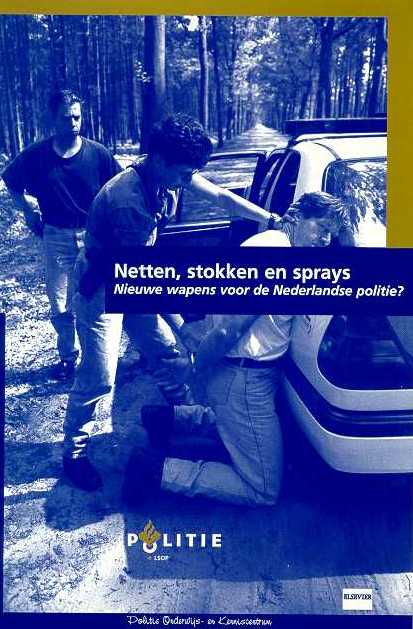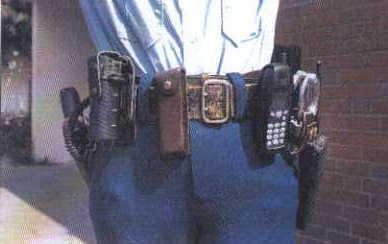SUMMARY
of
NETTEN, STOKKEN EN SPRAYS
NIEUWE WAPENS VOOR DE NEDERLANDSE POLITIE?
Amsterdam, Elsevier, 1999, ISBN 90-5749-384-5
Otto Adang, Robert van der Wateren & Jacques Steernberg
In the Dutch police, a discussion exists as to use-of-force options. All Dutch police officers are equipped with a short baton and a handgun. Some feel that a "gap" exists and several studies seem to indicate that a weapon intermediate between baton and handgun should be available for basic patrol duties. Some types of situations which policemen frequently encounter are perceived as especially troublesome, viz.
1. situations where officers are outnumbered by aggressive individuals
2. situations where officers face a (potentially aggressive) individual in the possession of a weapon (other than a firearm), e.g. club or knive
3. situations where officers face individuals behaving irrationally who do not respond to pain compliance (e.g. because they are intoxicated or mentally disturbed)
According to some, a higher level of professional skills would eliminate the need for an extra weapon, and the combined efforts of several policemen could do the job in most cases. According to others, the need for an extra weapon will still be felt, even if the level of professional skills is optimal.
Whatever the outcome of this discussion might be, the Interior Ministry has asked the Police Institute Public order and Safety and the Logistics Division of the National Police Services Agency to conduct an investigation into possible additional police weapons to be used for patrol duty. It has become clear that if an extra weapon for the Dutch police should be introduced, it should meet the following criteria:
- its use should not violate standard police practice and ethics;
- it should be designed and appropiate for use-of-force applications targeted at an individual;
- one police officer should be able to carry it, possibly (but not necessarily) as part of his personal equipment;
- it should be fast and easy to use;
- its use should be learnt easily;
- little or no aftercare should be necesaary after it is being used;
- medical risks of its use should be known and acceptable;
- use should result in as little injury as possible and certainly not to death;
- use should not result in unacceptable risks to third parties or the police officer using it;
- the use should make it easier to control suspects or should be an effective defense against an attack;
- it can be used both indoor and outdoors
- it is reliable
In light of these criteria the study focused on those weapons which are already in use in police departments abroad. In this way, information was available on the effectiveness of the weapon, risks involved with use of the weapon, skills needed and consequences for police action. The Interior Ministry has indicated that it wanted the study to focus on:
- nets;
- batons, with more options than the short baton;
- chemical sprays, especially peperspray.
In the course of the research, literature is studied and national and international experts were consulted to seek answers to the following questions:
1. for what type of situations are the weapons designed and appropiate?
2. what conditions should be met prior to the introduction of a specific weapon (e.g. rules relating to deployment)?
3. what should the training for a specific weapon look like?
4. what is known (based on independent research) about the effects of police use of these weapons?
The research led to the following conclusions:
1. The historically based choice for a general police role in which all police tasks are being dealt with fits well with a modern view on organisations with regard to effectiveness. Specialisation only takes place when absolutely necessary. As a consequence, police officers doing patrol duties have to be equipped and trained to be able to fullfill their role safely and responsibly.
2. It is unwise to put a one-sided emphasis on technology or equipment when dealing with the way the police applies its monopoly on the legitimate use of force. The ongoing discussion over the so-called gap between the baton and the fire-arm is not very helpful in this respect. There are no magic weapons. Realistic training in which officers are prepared for the situations they have to deal with are more valuable than the latest technology pushed onto the market.
3. Nets are deemed unsuitable for use on basic patrol duty in the Netherlands
4. Longer batons (straight or side-handle) provide an officer with more opportunities. Because of their length they are cumbersome to carry and best left in the vehicle, to be taken out only when needed. Side-handle batons seem attractive because or their multiple functionality including defense and control techniques. However, because of the necessary training requirements side-handle batons are deemed unfit for use on basic patrol duty in the Netherlands. Straight expendable batons seem more appropiate for use on basic patrol duty in the Netherlands. Under specified conditions, they might be a suitable replacement for the short baton.
5. CS-spray is deemed unsuitable for use on basic patrol duty in the Netherlands. Under specified conditions pepper spray may be appropiate for use on basic patrol duty in the Netherlands. However, pepper spray should not be considered as a fill of the so-called gap between the baton and the fire-arm.
6. Introduction of a new weapon should only be considered if certain conditions are strictly adhered to. The most important are:
- the ability to use the weapon should be subject te certfication;
- adequate and regular training must be compulsory;
- use of the weapon and its consequences has to be monitored closely;
- introduction should be accompanied by evaluation research.
7. Before a new weapon is bought and introduced the following needs to be done:
- writing specifications;
- writing of a trainingprogramme and setting standards officers will have to meet;
- training of instructors;
- training of officers;
- writing of a policy;
- possibly making changes to the uniform.
Whenever a new weapon is introduced, the real possibility exists that it will be misused and that officers will use force more often than they used to do. Yet, officers should be equipped properly for them to be able to do their jobs. In the end, the choice will not be a scientific, but a political one, and it will depend in part on the way in which the police does or does not behave professionally.
Pepper Spray in the Netherlands
In the Netherlands, police officers are routinely equipped with a fire-arm, a short baton and hand-coughs. Since 2003, police officers in all Dutch police forces are also equipped with pepper (OC-)spray. Civilians are not allowed to carry OC-spray.
A new weapon? (1998 - 1999)
After a discussion lasting several years over the need for and choice of a new non/less-lethal weapon, the Dutch government decided to conduct street trials with pepper spray in a limited number of forces. This decision was based on information provided by earlier research commissioned by the Dutch Interior Ministry, notably studies by TNO on medical and toxicological aspects and an internationally comparative study by the Police Academy of the Netherlands on the merits of different types of so-called non-lethal/ less-lethal weapons
(Read summary >>).
Street trials (2000)
Starting July 3, 2000, approx. 3000 police officers in four police forces were equipped with (natural) pepperspray for a trial period of six months. The street trials were scientifically evaluated to answer the question whether pepperspray was a safe and adequate use-of-force option for the Dutch police and under what conditions (guidelines, training, supervision, aftercare) pepperspray could be made available to all officers in the Netherlands. All conclusions and recommendations of the final report were accepted by the Dutch Interior minister.
Nationwide introduction of OC-spray (2001- 2002)
Between June 2001 – December 2002 pepperspray was introduced as a new weapon for all Dutch police forces. The report on the introduction draws conclusions with relation to logistical, organisational and educational aspects.
As a result of recommendations made after the street trials, changes were made in training. These changes proved to be succesful. Still, some points of attention remained: cross-contamination of officers and bystanders should be reduced further, officers should not forego the required warning and pepperspray was used too often from a distance of less than 1 meter. All of these matters are an indication of tactical imperfections. In addition, not all suspects arrested with the help of pepperspray received the prescribed after-care. Further points of attention were the questionable improvised use of pepper spray (by rubbing it in the face of a suspect), the use of pepper pray against suspects that were already in handcoughs and against suspects already in custody. Use of pepper spray by off-duty officers was rare, but it was worrying that an unknown quantity of officers carried pepper spray when off-duty, without there being any regulation in this matter.
Six to 15 per cent of all uses of pepper spray were against suspects that did not pose any threat to the officer concerned or to others. In light of the painful effects of pepper spray and the discussion that took place during the street trials about the right place of pepper spray in the use-of-force continuum, it is important to ensure that pepper spray is not deployed all too easily. This would not only be in disregard of the principles of subsidiarity and proportionality. It would also harm the police image and public acceptance of pepper spray as a proper police weapon.
An analysis of 1882 reports concerning 1603 incidents in which an individual was actually sprayed with pepperspray (one incident could involve more than one officer or suspect) indicated that officers seemed justly satisfied with pepperspray: OC-spray makes it possible to effectively control a (potentially) dangerous suspect from a safe distance and without serious consequences. The availability of pepperspray was often effective in itself, and this preventive effect seemed to get stronger. However, compared with the previously held street trials, effectiveness of actual use of OC-spray seemed to have diminished. Adang et al. (2006) report on the analysis of these data and look specifically at factors influencing effectiveness of OC-spray.
(See: Otto M.J. Adang, Robert J. Kaminski, Megan Q. Howell, Jos Mensink, 2006, Assessing the performance of pepper spray in use-of-force encounters: the Dutch experience, Policing, Vol 29, No 2, pp 282 - 305)
Continued research and monitoring (2003 - 2004)



